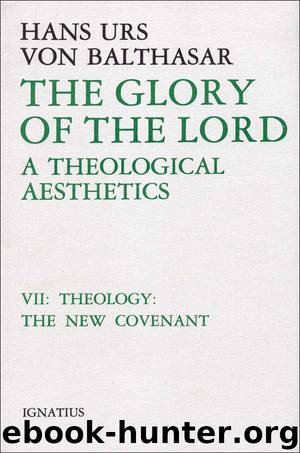The Glory of the Lord, Vol. 7 by Hans Urs von Balthasar

Author:Hans Urs von Balthasar [Balthasar, Hans Urs von]
Language: eng
Format: mobi
Tags: Spiritual & Religion
ISBN: 9780898702491
Publisher: Ignatius Press
Published: 1990-05-31T16:00:00+00:00
b. Hidden Easter
1. The inauguration of the kingdom and the dawning of glory are one and the same thing in Jewish hopes. It was therefore inevitable that the Resurrection of the dead Lord into immortal life and the parousia should coincide; in Jesus’ eschatological horizon, they had to. But it is striking that the word ‘glory’ never occurs in the context of the accounts of the risen Lord: it is only subsequent theological reflection that comes to see that the elemental impact of the kabod in God’s action in the crucified one must imply a correspondingly elemental impact of the kabod in his action in the one who is raised up. If Rom 6.4 says that the Son was raised up ‘through the δόξα of the Father’, 1 Cor 6.14 goes on to say that ‘his δύναμις’ raised him up.1 Eph 1.20 cannot find sufficiently exalted expressions to say what the ‘Father of glory’ has done in the event of the Resurrection. The reflection understands that the Resurrection is the ‘fulfilment’ of the promise, made a long time before, that the barriers of death would be broken through; this fulfilment makes present the ‘fullness’ (πλήρωμα) of the riches (πλοῦτος) which, since it is God’s property, is a ‘wealth of glory’ (Rom 9.23; Eph 1.18; Phil 4.19; 3.16; Col 1.27). Thus the sermons of the Acts of the Apostles speak unabashedly and without distinction of the Resurrection of Jesus as ‘exaltation to God’s right hand’ (2.33) and the ‘glorification’ of Jesus (3.13; both terms are found together at Is 52.13). 1 Pet 1.21 speaks of the God who has ‘raised’Jesus ‘from the dead and given him glory’ (cf. 1 Pet 1.11). Indeed, the Lucan Christ gives the disciples on the road to Emmaus theological instruction: ‘Was it not necessary for the Christ to suffer these things, and thus to enter his glory?’ (24.26).2 The liturgical hymn at 1 Tim 3.16 speaks of him in the last line as ‘having been taken up in glory’, and the Letter to the Hebrews goes so far as to say that ‘we see him crowned with glory and honour’ because he suffered unto death (2.9), with ‘a far greater glory’ than Moses once received, in that Jesus is invited to sit at the right hand of the Father (1.13; 8.1; 10.12).
This ingenuous theological language contrasts with the simplicity of the Easter narratives. Although Jesus appears several times ‘in unwonted form’ (Mk 16.12; Lk 24.16; Jn 20.15; 21.4), this metamorphosis bears no quality of transfiguration. It is pure concealment, a transitory desire not to be recognised. There is neither brilliant light nor overwhelming impact in the Gospel recognition scenes. On the contrary, the close of Matthew already betrays a stylised character, as the pantocrator speaks tunelessly from Heaven on high. It is only the resurrection angels with their shining garments who indicate—though virtually only in a symbolic way—the atmosphere of δόξα (Mk 16.5; Lk 24.4; Jn 20.12), but this is less defined than with the Christmas angel in Luke, with whom ‘the glory of God’ shines forth (2.
Download
This site does not store any files on its server. We only index and link to content provided by other sites. Please contact the content providers to delete copyright contents if any and email us, we'll remove relevant links or contents immediately.
The Lost Art of Listening by Michael P. Nichols(6472)
Why I Am Not A Calvinist by Dr. Peter S. Ruckman(3769)
The Rosicrucians by Christopher McIntosh(3049)
Wicca: a guide for the solitary practitioner by Scott Cunningham(2704)
Signature in the Cell: DNA and the Evidence for Intelligent Design by Stephen C. Meyer(2501)
Real Sex by Lauren F. Winner(2474)
The Holy Spirit by Billy Graham(2416)
To Light a Sacred Flame by Silver RavenWolf(2353)
The End of Faith by Sam Harris(2288)
The Gnostic Gospels by Pagels Elaine(2026)
Nine Parts of Desire by Geraldine Brooks(2006)
Waking Up by Sam Harris(1958)
Heavens on Earth by Michael Shermer(1955)
Devil, The by Almond Philip C(1899)
Jesus by Paul Johnson(1887)
The God delusion by Richard Dawkins(1848)
Kundalini by Gopi Krishna(1824)
Chosen by God by R. C. Sproul(1760)
The Nature of Consciousness by Rupert Spira(1689)
